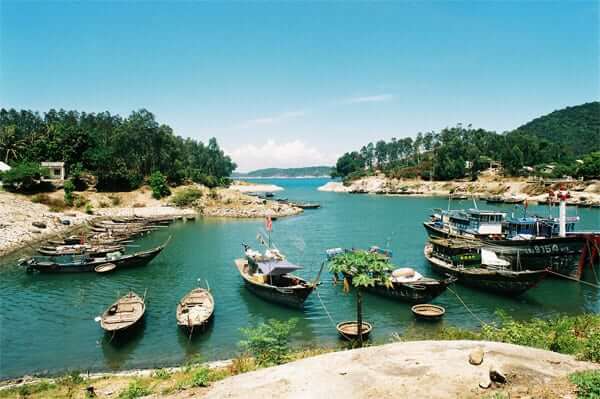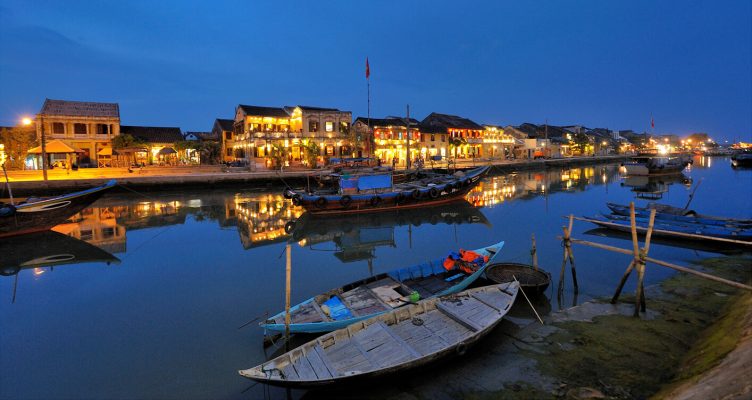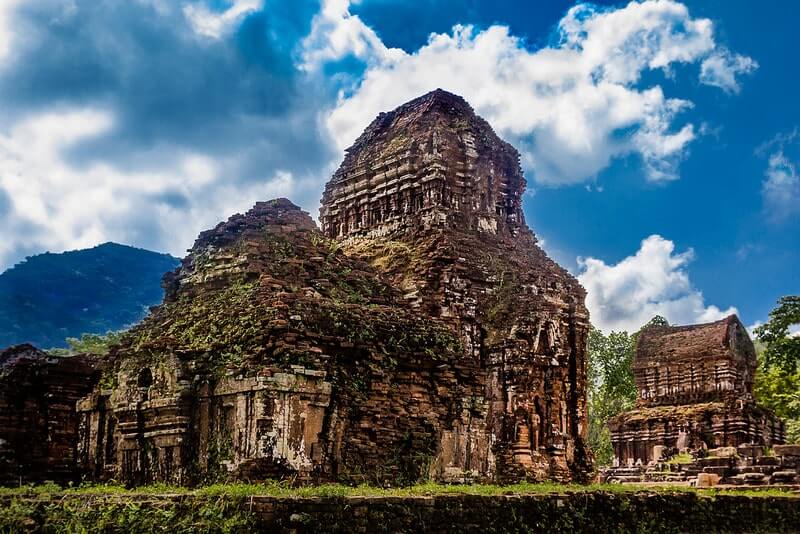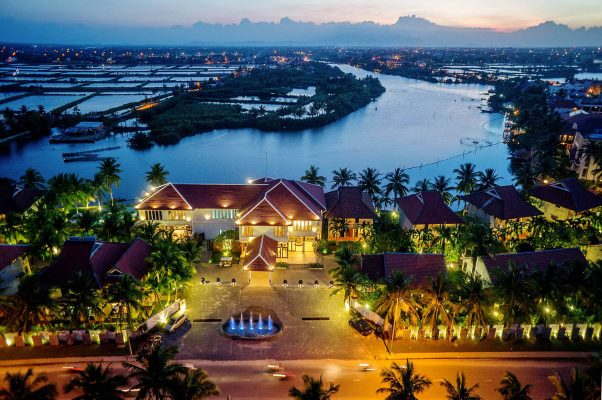Quang Nam is located in the middle of Vietnam, 860 km north of Hanoi, 865 km south of Saigon. With the average position of the country, the intersection between 2 geographic tectonic regions, the intersection of two regions of the North-South climate, the diverse topography with mountains, midlands, and coastal plains along with the advantages of its rich history, culture, people, and landscapes, Quang Nam tourism has many conditions for development. Through many ups and downs of events, Quang Nam still retains its very unique cultural resources with profound human values, recording the brilliant imprint of the culture of Sa Huynh, Champa, Dai Viet.
Table of Contents
General introduction to Quang Nam
Previously, Quang Nam was the land of Chiem Thanh, in 1306, according to the agreement between King Chiem Thanh, Che Man and King Dai Viet, Tran Nhan Tong, King Che Man offered two continents, Thuan Chau (northern Hai Van) and Chau Ri, Hoa. Chau (Nam Hai Van) married the daughter of King Tran Nhan Tong, Princess Huyen Tran. The Vietnamese gradually settled in two new lands, the Chiem Thanh gradually retreated to the remaining land in the south of the kingdom. In 1471, after occupying the land south of Thuan Hoa until Cu Mong pass, King Le Thanh Tong established the 13th administrative unit – Thua Tuyen Quang Nam, consisting of 3 palaces: Thang Hoa, Tu Nghia, and Hoai Nhon (now Quang Nam, Quang Ngai, Binh Dinh). The title Quang Nam appears from here.
Quang Nam residents are a community during the water opening process. The Vietnamese (Kinh) were present in Quang Nam before 1471, together with the Champa and the Chinese. Nowadays, in Quang Nam, in addition to the pure Vietnamese and Chinese people, there are also Vietnamese (Kinh) whose long-standing ancestors are Chinese people (Minh Huong people).
Quang Nam is a coastal province, located in the central key economic region, a province with mountainous, midland, plains, urban areas, coastal sandy areas, and islands. Quang Nam is located in the key economic region of Central Vietnam, the North borders Da Nang City, the South borders Dung Quat economic zone, has an airport, seaport, Xuyen A road, so it is very convenient for exchange and development of social and economic importance in security and defense.
Throughout the history of formation and development, Quang Nam – with the meaning of a large land to the South – was formed quite early and known as “cultural land”, “scientific land”, “land” The “masterpiece spirit” has produced so many talents for the country.
Not only that, Quang Nam refers to a land of “loyalty and resilience”, rich in patriotism and revolutionary traditions that have nurtured outstanding celebrities, heroic Vietnamese Mothers.
Quang Nam has extremely favorable geography to connect other localities of Vietnam and the world; it has rich natural resources. As the only locality in Vietnam with 2 world cultural heritages, My Son ancient temple and tower area and Hoi An ancient town. In addition, this land also has a World Biosphere Reserve of Cu Lao Cham Island with wild beauty, many rare and precious products. There are 125 km of white sandy beaches, golden sunshine, many beaches with famous beautiful scenery, voted by Forbes magazine as one of the most beautiful beaches on the planet, so it is convenient for ecotourism and resort development.
When should you travel to Quang Nam?
Quang Nam is located in a typical tropical climate, with only 2 seasons, the dry and the rainy season, less influenced by the cold winter in the North. The average annual temperature is 20 – 21ºC, there is no big difference between months of the year. You can arrange Quang Nam tourism in the dry months, so avoid the peak of the rainy season because floods often rise and flood the whole province.
Go to Hoi An on the 14th of every month to attend the night of the old town. On this occasion, you will have the opportunity to listen to traditional songs, play folk games and enjoy delicious food, especially watching the red lanterns fluttering around the street.
If you want to explore Cu Lao Cham more, you can go in the middle of summer, the hot weather will be suitable for marine exploration activities.
Around April is the season of flowers in Tam Ky, at this time, the streets of Tam Ky will be filled with brilliant yellow colors everywhere. If you love this flower, you can go to Huong Tra village to see the ancient garden of thousands of trees.
Guide to Quang Nam
By Public transport
By Car
From Hanoi and Saigon (as well as famous tourist destinations along the other two ends of the country), there are high-quality car routes and buses to Quang Nam. If you do not mind cramped space, long hours and want to save travel costs, you can choose this option. No need to switch back and forth between different types of vehicles.
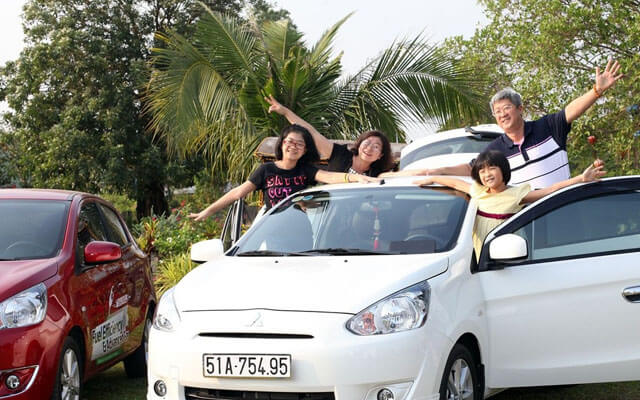
By Planes
Quang Nam currently has Chu Lai Airport, the largest airport in Vietnam, and is being planned to become an international airport. The domestic airlines currently have direct flights to Chu Lai with daily frequency. However, depending on the actual situation of the trip, you can choose to fly to Chu Lai if you plan to travel to Tam Ky, Tam Thanh because the distance from these places to Chu Lai is quite close. If you only plan to go to Hoi An, you can choose Da Nang airport for more convenience in terms of travel.

By Train
Similar to the flight plan, if you take the train, you also have 2 options: Da Nang station (30km) and Tam Ky station (50km) depending on the destination you intend to stop when you arrive in Quang Nam. If you are from Hanoi and the North, you should stop at Da Nang station if you go to Hoi An, if you are from Saigon and the South, no matter where you plan to go, you should stop at Tam Ky station to save time in your work. move.
- From Hanoi, there are 6 daily trains to Da Nang, namely SE1, SE3, SE5, SE7, SE9, SE19. In terms of the reasonable travel time, you may be interested in the train SE1 (from Hanoi 22:20 to Da Nang 13:25) SE3 (from Hanoi 19:30 to Da Nang 11:05), or SE19 (go from Hanoi 20:10 to Da Nang 12:20)
- From Saigon, there are 5 daily trains to Tam Ky, namely SE2, SE4, SE8, SE10, and SE22. Similarly, the trains to Tam Ky during the day are SE2 (going from Saigon 9:55 to Tam Ky 12:24) SE4 (going from Saigon 19:45 and arriving Tam Ky at 11:08), and SE22 (going from Saigon at 14:40 and arriving in Tam Period at 8:12).
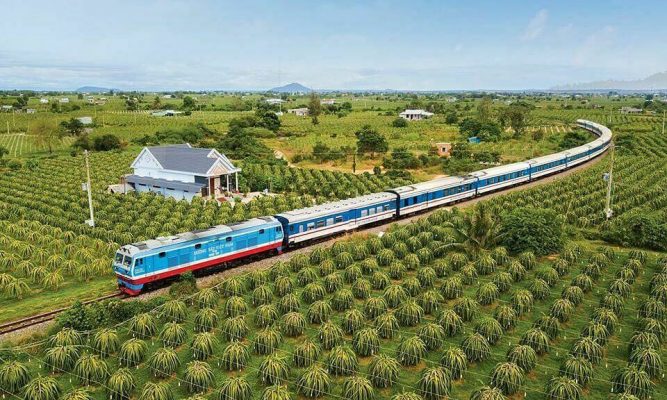
By Private vehicles
For those of you who like to travel with family or friends on your own vehicle, along QL1A you can explore many places such as Ninh Binh, Thanh Hoa, Nghe An, Ha Tinh, Quang Binh, Quang Tri, Thua Thien Hue, and Da Nang (if traveling from the North) and famous tourist destinations along the South Central Coast (if traveling from the South).
Traveling in Quang Nam
By Bus
In Quang Nam, there are many public bus routes, convenient for tourists to travel. such as the routes: Hoi An – Da Nang, Tam Ky – Nui Thanh, Tam Ky – Bac Tra My, Tam Ky – Hiep Duc, Tam Ky – Dai Loc, Tam Ky – Da Nang, Nam Phuoc – Da Nang with the opening time dynamic from 5:30 to 18:30 daily (depending on the time of operation the last trip will be between 17h-18h30).
By Motorbike
If you want to explore Quang Nam comfortably, even up to the highland districts of Quang Nam, perhaps the motorbike rental option will be most suitable for you. In case you can bring your personal motorbike from home (via sending your motorbike by train) it is even more wonderful.
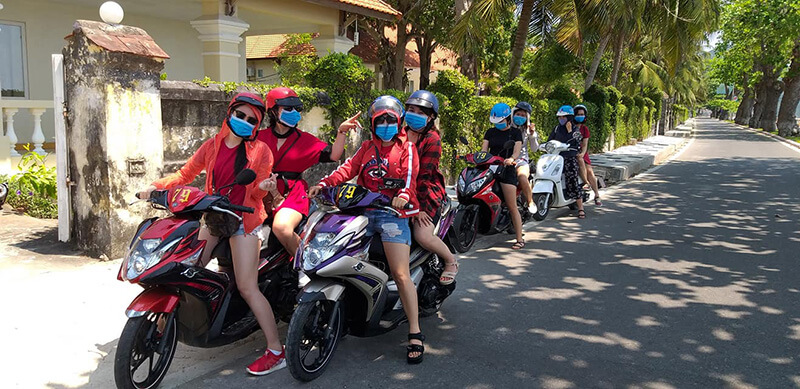
By Bicycle Vehicle
If you come to Hoi An, you should note that the downtown area of Hoi An is quite small and banned from motor vehicles, so you can only walk by bike or rent a cyclo to go out. Most hotels, motels, and resorts in Hoi An have bicycles ready for guests to borrow. If you want to go further distances you can call a taxi or find motorbike rental locations.
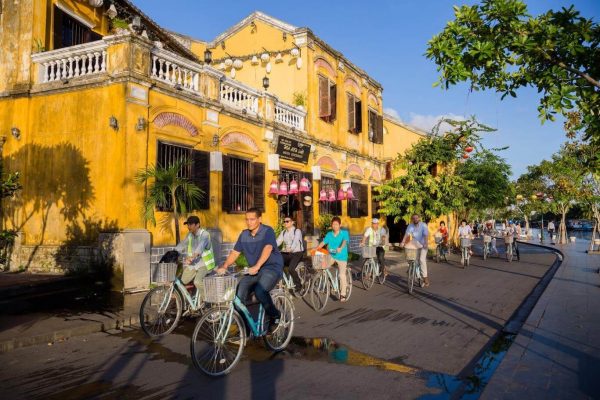
Staying in Quang Nam
Quang Nam province currently has about 600 tourist accommodation establishments of all kinds with a total of more than 10,000 rooms. In which the number of hotels accounts for about 30%, homestay accounts for about 50%. The number of hotel rooms is mainly distributed in Hoi An (about 90%), the rest are scattered throughout the districts and towns in the province.
Hotels and resorts in Quang Nam
In tourist centers in the province such as Hoi An or Tam Ky, you can easily find a hotel, from small-scale to high-class 4-5 star hotels. Compared to other forms of accommodation, hotels are often more synchronous in terms of management and service as well as often have beautiful locations, closer to the center for tourists to refer to.
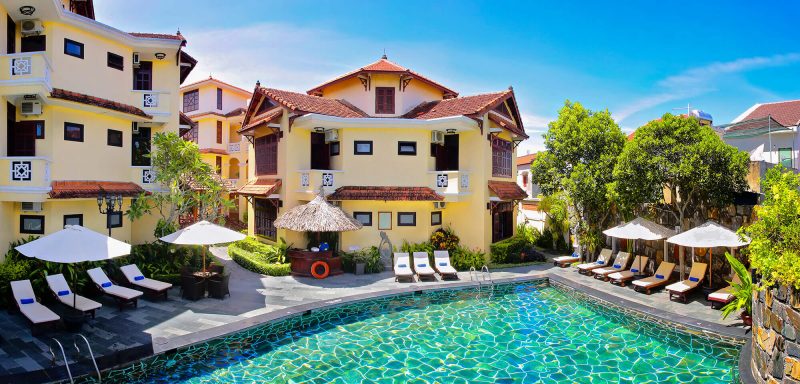
Quang Nam Vacation Rentals
This is a popular and idyllic type of accommodation, especially in remote districts in the province. This type of accommodation is usually concentrated in the center of the district (town) and has a fairly affordable price, suitable for many types of people from young people who like cheap backpacking, adventure travel to the group. You go on business to come here and take advantage of you to stay for tourism.
Tourist Villas
This form of accommodation is quite developed in Hoi An in recent years, so much so that the city government has to stop licensing the implementation of these forms. The houses built with villas (villas) are designed by homeowners to make many rooms for tourists to rent, the quality is relatively good and the price is much cheaper than large hotels. The villas also have a full swimming pool, cleaning, and dining services to provide for guests always.
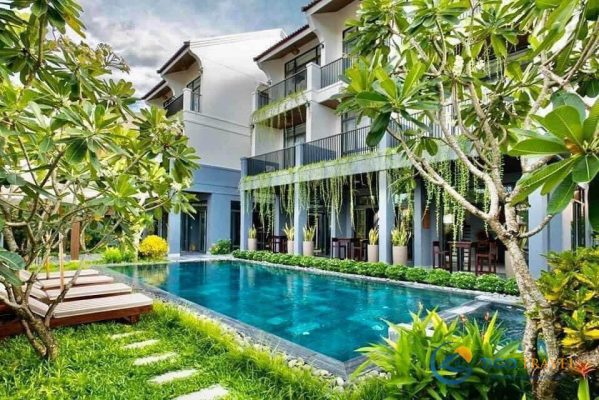
Homestay in Quang Nam
Model of community accommodation, living, and accommodation with local people. However, in reality, the current homestay model is almost the same as a hotel, is better designed, and has common living spaces in the house so that groups of tourists can interact with each other. Coming to Quang Nam, you can easily find a homestay in Hoi An, or you can also visit the beautiful island of Cu Lao Cham to experience a true homestay.
Tourist attractions in Quang Nam
Hoi An
Hoi An Old City
The Old Quarter is located entirely in Minh An Ward, an area of about 2 km², with short and narrow streets, with winding sections, running horizontally along with the chessboard style. Located close to the riverbank is Bach Dang street, next to Nguyen Thai Hoc street and Tran Phu street, connecting with Nguyen Thi Minh Khai by Cau Pagoda. Due to the gradual inclination of the street’s terrain from North to South, the horizontal roads of Nguyen Hue, Le Loi, Hoang Van Thu, and Tran Quy Cap are slightly steeper if going back into the city. Formerly Tran Phu Street was the main street of the town, connecting the Covered Bridge to the Chaozhou Assembly Hall. During the French colonial period, this street was named Rue du Pont Japonais, or Japanese Bridge Street.
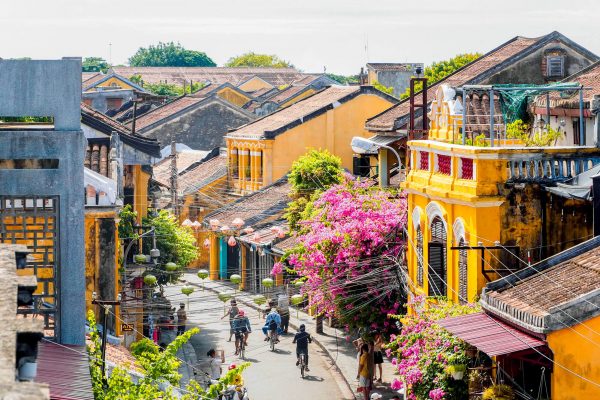
Today, Tran Phu Street is about 5 meters wide with many houses without a veranda, the result of the expansion around the end of the 19th century and early 20th century. The two streets Nguyen Thai Hoc and Bach Dang were formed later, filled with mud and soil. Nguyen Thai Hoc street appeared in 1840, then was named Rue Cantonnais by the French, or Guangdong people’s street. Bach Dang Street was born in 1878, located close to the riverbank, so in the past, it was called the River Bo River. Located deep in the city, next to Tran Phu Street is Phan Chu Trinh Street, a new road built in later times. In the old town, there are many other alleys located perpendicular to the main road extending to the riverbank.
Cu Lao Cham
With 8 small islands stretching in the shape of a green bow, Cu Lao Cham is one of many unspoiled islands that have been exploited in recent years in Quang Nam. Those who first come to Cu Lao Cham are likely to be captivated by this island. The pristine blue color of the forest tree is connected to the blue of the sea by a smooth white sand ribbon, sparkling under the golden sunlight and deep blue sky,…
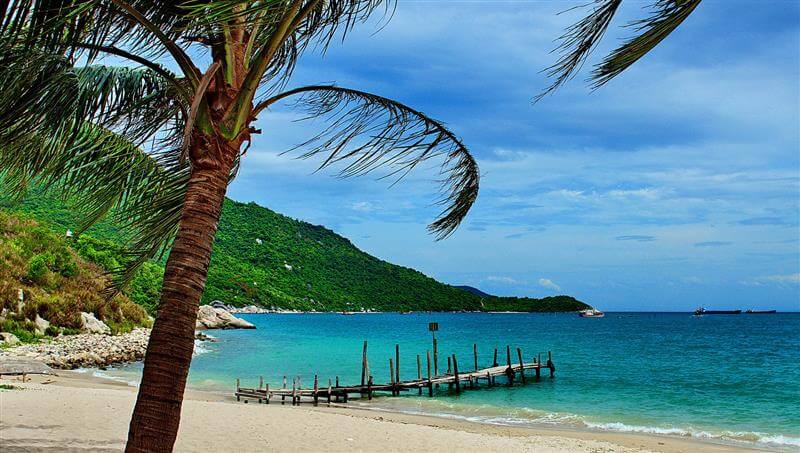
Tam Ky
Tam Thanh Fresco Village
From Tam Thanh beach, about 5 minutes by motorbike to Trung Thanh village, there is the first mural village in Vietnam. This village has just been drawn in June in a project by the HQ International Exchange Fund (Korea Foundation) and the United Nations Settlement Program (UN-Habitat). There are about 70 colorful murals made by 5 Korean artists and a volunteer team within 3 weeks.
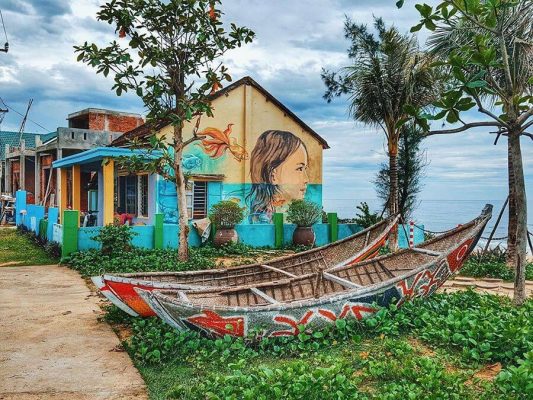
Tam Thanh Beach
Located 07 km east of Tam Ky city center, Tam Thanh is a clean, beautiful, and fresh beach. Tam Thanh Beach is the convergence of all the necessary conditions for tourism development: a beautiful beach with a sandy beach for kilometers.
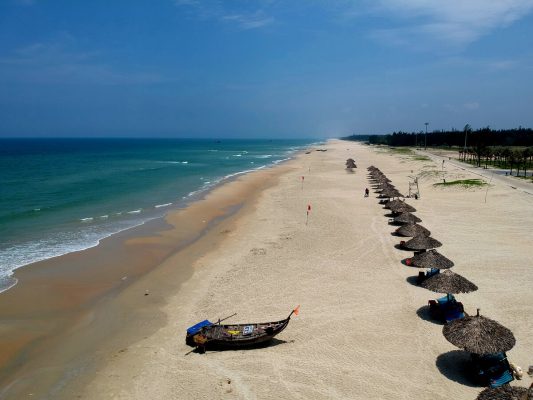
Monument to Vietnamese Heroic Mother
This monument was taken as a prototype from Nguyen Thi Thu’s mother (Dien Thang commune, Dien Ban district, Quang Nam). Thu’s mother had 9 sons, a son-in-law, and two grandchildren who died in two struggles against France and America. The cascades from the large statue are like the tears pouring out of the mother when all 9 children leave one by one. This monument captures the deep gratitude of the people of Quang Nam for the sacrifices for the homeland of heroic Vietnamese mothers.
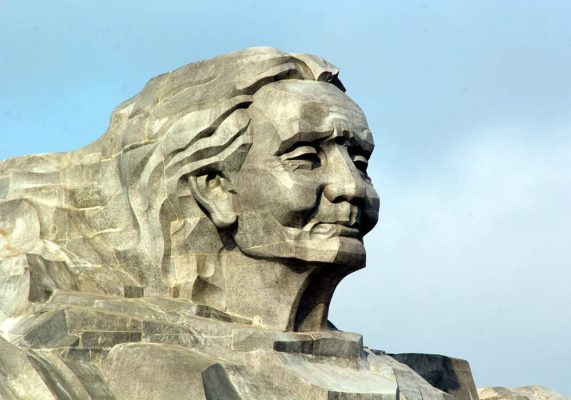
Ky Anh Tunnels
Ky Anh Tunnels, one of the three largest tunnels in Vietnam (after Cu Chi Tunnels in Saigon and Vinh Moc in Quang Tri). Ky Anh tunnels started digging in 5/1965 and were completed in 1967. The total length of the tunnels is about 32km, the width is from 0.5 to 0.8 meters, the height is about 0.8-1 meters, the length of the tunnel depends on the terrain. in each village (there is a very narrow place in the tunnel, in the case when the enemy detects the mouth of the tunnel, throws it down with tear gas or grenades, we can easily block the rest of the space to avoid casualties). The tunnels also have ambulance tunnels, combat tunnels, command tunnels, food, and food silos,… with a capacity of 1,500 people.
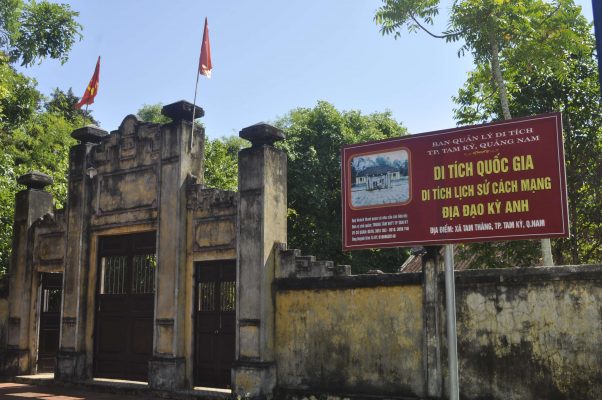
Van Thanh – Confucius Temple
Van Thanh – Khong Mieu is located in an area of 6200 m2, located next to Phan Boi Chau Street, Tam Ky City. The relic Van Thanh – Khong Mieu with relics including the main hall, the back hall, the bell tower, the empty tower, two rows of bridges, the ancient folk houses of Quang Nam, the bridge over the lotus lake, and the gate of Tam Quan. This is a place to worship Confucius and hold a training course on Confucian thought, with a unique cultural architectural and artistic complex, converging folk cultural traditions, ethnic groups dating back more than 300 years.
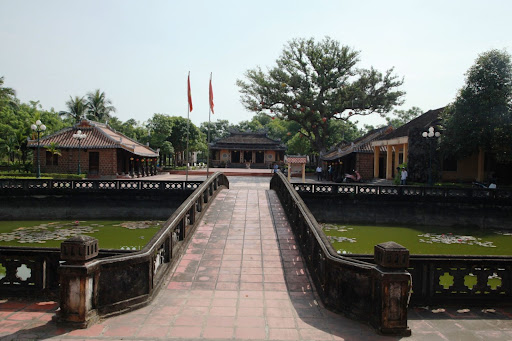
Quang Nam Museum
Quang Nam Museum is located at 281 Phan Boi Chau Street, Tam Ky City, Quang Nam Province. There is a total usable area of 21,976 m²; of which, the construction floor area is 7,322 m², the outdoor display area is 1,305 m², the statue garden of the famous 1,004 m², the cultural construction area of the ethnic Quang Nam 2,164 m²,… The interior display of the Museum. has an area of 2,700 m², including natural features and resources; ethnic cultures in the province, and the history and society of Quang Nam province. There is also a thematic booth to serve local political and cultural events.
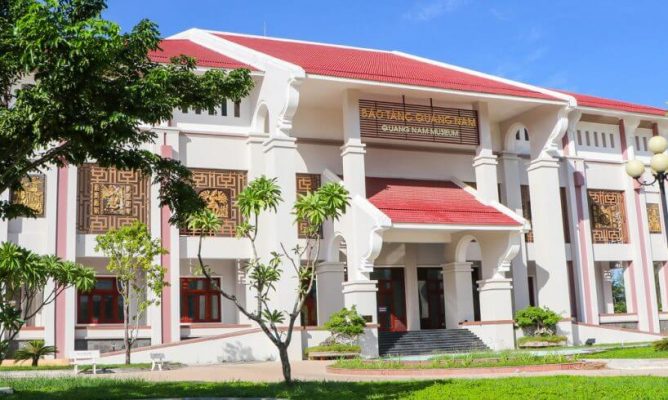
Chien Dan Tower
Chien Dan Tower is located 5km north of Tam Ky city and right next to National Highway 1A. Currently, at the Chien Dan relic, there is a display of the most typical sculptures, and also displays a very large set of Yoni – Linga found at the Champa ruins in My An, located far from Chien Dan 1.5 km southwest.
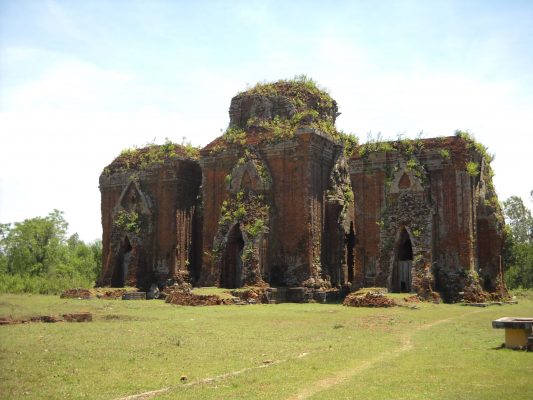
This is a group of 3 towers lined up in the North-South axis, the entrance is to the East. The towers in Chien Dan have nearly the same shape, the tower plan is square, the roof of the tower is gradually reduced upwards. There are no decorative patterns on the body of the towers, but adjacent to the top of the tower, there are sandstone frills carved on many sides of Kala lined up horizontally. Here, many decorative objects, sculptures of high artistic value have been discovered, especially the Yoni altar and the human and animal statues (Naga snake statue, Hamsa goose, Garuda bird, god elephant. Gajasimha,…) is shown in the style of Chanh Lo (in the late 11th and early 12th centuries).
Tay Giang
Possessing a pristine and charming forest ecosystem such as pompano, rhododendron, old ironwood forest,… Tay Giang is gradually being exploited for tourism. In which, more than 50ha of azalea forest is considered a highlight with the regular azalea flower festival held. Not only has the advantage of magnificent pristine nature, cool climate all year round, Tay Giang is also a land rich in the cultural identity of the Co Tu ethnic group. This is a factor for this locality to prioritize investment in the type of ecotourism suitable for the cultural characteristics of the upland village. These include the cultural village of Po’ning village, Arơch residential area (Lang commune), the villages of A Nong commune, the ecotourism village Azut (Bha’Lê), the village of Aren I (A Xan), the village of the border. The Ch’noc (Ch’m’m) world,…
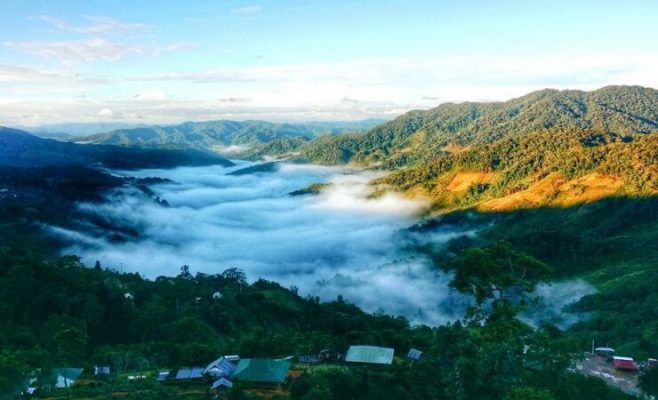
Que Peak
Que Peak is considered the most beautiful mountain in Quang Nam with an altitude of 1369m above sea level, so it seems to be covered all year round. Over hundreds of kilometers of passes, you will admire the beautiful scenery. It is a white “sea of clouds” under the light of dawn or sunset, sometimes it is an open landscape with drifting clouds, opening up a majestic mountain and forest space. Standing at the top of Que, you will feel as if you just stretch out your hand to reach the clouds, to the sky.
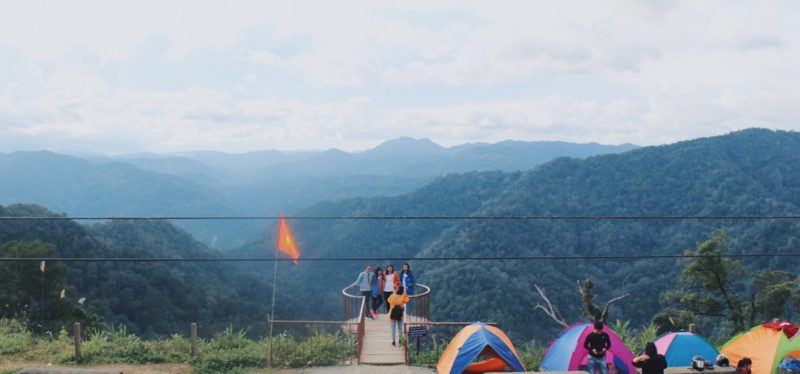
Dong Giang
Dong Giang Community Tourism
For a few years now, on the Quang Nam tourist map of tourists and travel businesses, Dong Giang has appeared as a familiar name, the most prominent of which are the two villages of Bhơ Hoồng (Kon River) and Đhrôồng. (Ta Lu). In addition to the diverse culture, charming scenery, cool climate,… one of the most prominent advantages of Dong Giang tourism is that most of the points are located along with National Highway 14G and the Ho Chi Minh trail, so it is very convenient to connect. linking sightseeing tours.
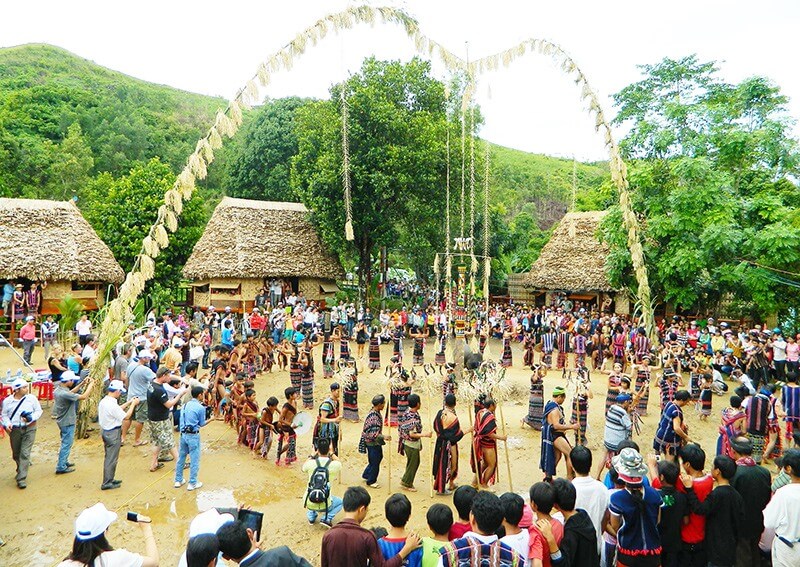
However, Dong Giang tourism not only has Bho Hoong and Dong Giang but also owns many unique destinations that are interested in tourists such as the longhouse of Y Kong village patriarch (Ba commune), a lively museum. storing many traditional cultural values of Co Tu; is A Dinh waterfall (P’Rao), the deserted Silk Waterfall (A Ting) in the middle of the old forest with more than a dozen small waterfalls stretching successively for hundreds of meters; that is Hang Gap (Ma Cooih commune), is the lake bed of A Vuong hydropower plant with four clear seasons,… In particular, it is impossible not to mention Tay Tien Ba Na primeval forest (Tu commune) where fresh air still preserves the rich vegetation and many rare species of flora and fauna, which are considered to have potential function is not inferior to the neighboring Ba Na Nui Chua tourist area (Da Nang).
Dong Giang Tea Hill
These tea hills belong to Quyet Thang State Farm, located about 1 hour from Da Nang by motorbike and close to Highway 14B. This land has fresh air and lots of rain, so tea trees have been growing well for decades.
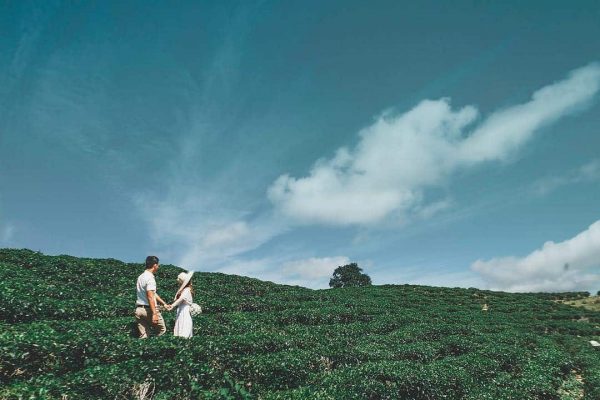
Dong Giang Skygate
“Heaven Gate” or “Hang Gop” is the name of the people in Kà Đau village (Kà Dàng commune, Đông Giang district). It consists of a giant limestone dome connecting two hilltops to form an arch or gate. From the sky gate, walking inside for about 30 minutes, there is a cave consisting of many large and small caves formed by the flowing water for thousands of years with many beautiful nipples, and there are also many waterfalls and cool streams,… very few people know.
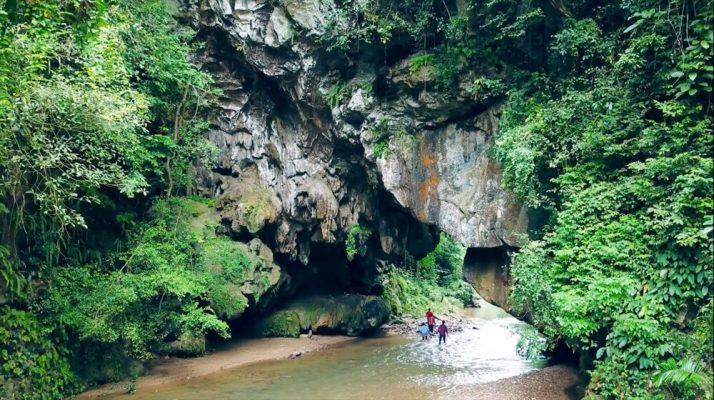
Nam Giang
Nam Giang is considered one of the mountainous districts with great potential and advantages for tourism development. Nam Giang has now formed tourism products: Garang waterfall, district traditional house, Ba Xua dance group, Za Ra brocade weaving cooperative, Co Tu life group in Pa Rong village, musical instrument group, group Co Tu life in Pa Ting village, cooking Ca Dang, cooking Pa Ia, knitting, dancing Pa Va.
Grang Waterfall
Grang waterfall is a cluster of three-tier cascades, so it is called three cascades. The most beautiful is probably waterfall 3 with a height of more than 30 meters, spreading misty water, spreading white hair on the mossy cliffs. This is the place where tourists stop to visit the most. However, if you have “soft rock hard legs”, you can follow the trail up the steep mountain slope to see the beauty of the above two floors. All three floors of the waterfall evoke the wild pristine beauty of a female mountain girl in the wild.
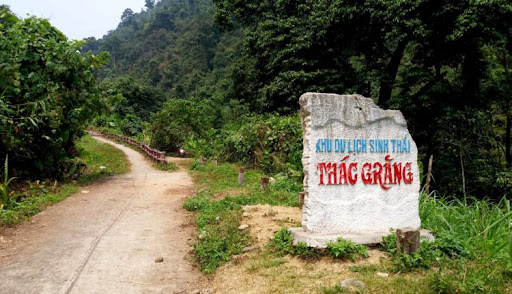
Dai Loc
Spring Apricots
Located 10km from the center of Dai Loc district to the west, the Suoi Mo eco-tourism area is one of the interesting attractions, each year welcoming about 8,000 visitors to play, enjoy and visit the Palace of the Lady of the Jade.
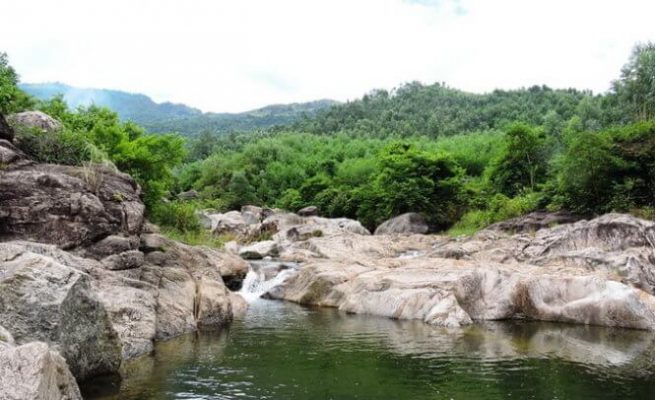
Suoi Mo has a wide ravine with many beautiful streams hidden in the wild, lonely forest. From a distance, the stream is clear and blue like soft silk ribbons squeezing through each rock slot. At some point, the stream flows gurgling through rocks of all colors and sizes; There is a stream of streams flowing, white effervescent through the great rock rapids, creating products of thousands of years. Follow the trails beside the rocky rapids about 100m high, to find the majestic, bubbling Giay waterfall, tumbling down into a deep pond with blue water. Tiny droplets of water scattered on the trees, looking away from the silver a virtual white mist. The enchanting and majestic beauty of streams and falls together with a thousand-year-old rock complex is suitable for those who like to explore, harmonize with wild nature.
Khe Tan Lake
Khe Tan reservoir is located on road 14B from Da Nang to Ho Chi Minh Road. The lake is tectonic at an altitude of 300 meters above sea level with a lake basin of 840 hectares, with a capacity of 46 million cubic meters of water.
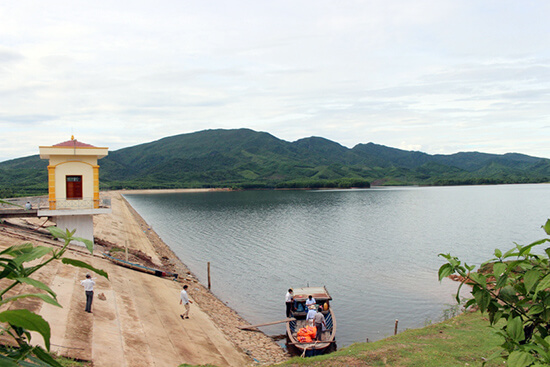
In the lake bed, there are dozens of islands, large and small, creating a charming landscape. Tourist boats take tourists to Rach Stream, Du Stream,… to watch the white waterfall in the middle of the pristine forest. There are many beautiful stalactites in the stream bed. An Bang and Huu Nien primitive forests are interwoven with planted forests with many kinds of plants such as gongs, sausages, chestnut, sage, raindrops, and many kinds of birds and animals such as deer, gills, porcupines, weasels, chickens. forest, wild boar, cork, cane bird, white stork,… create the richness and diversity of attractive wild nature.
Khe Lim
Khe Lim is located in Dai Hong commune, about 20km southwest of Ai Nghia town. Among the landmarks in Quang Nam, Slot Lim is classified as a list of beautiful places to explore. This place not only has a majestic waterfall or the wild beauty of mountains and forests but is also associated with mysterious spiritual stories.
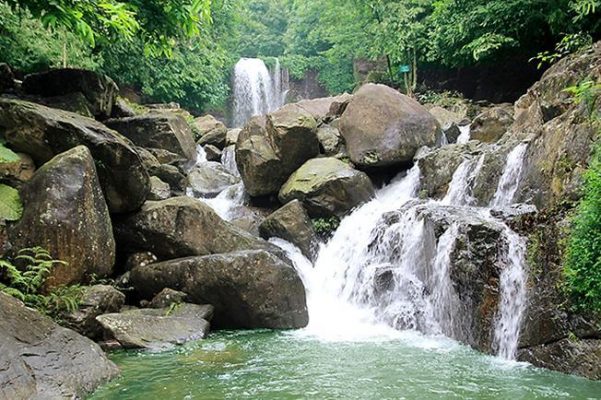
Looking back from a distance, Khe Lim glistens like a white silk strip at the top of a green mountain. From above, the water rushed down and chased each other through the big round rocks flowing downstream, along the way the water eroded cliffs to create bizarre burrows. It is said that the uniqueness of Lim’s slot is pristine but also full of mystery. It is not only the dense forest canopy covering the two sides of the stream or thousands of large and round rocks like giant eggs lying about but also the mystery that exists in every wind blowing through the leaves and the sound of birds. lost in the middle of midday, making those who are brave the most can’t help,… chills.
Dien Ban
Ha My Beach
The typical attraction of Ha My beach is its wild beauty and the blending of natural and heavenly landscapes, where the fishing baskets are located lazily and the tourist areas are stretching endlessly. Not many noisy waves, but Ha My beach still has its charm with open space and a long, comfortable beach, adorned with the wildness of countless purple sea lilies.
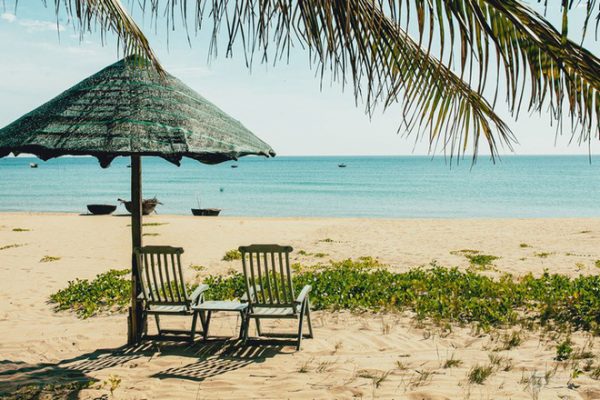
Bang An Tower
According to recorded history, Bang An Tower is a typical architecture for the spirituality and worshiping beliefs of the Champa nation in the past, built in the ninth or tenth century, that is, before the time of building the pagoda. Dien Huu (One Pillar Pagoda) in Hanoi.
The tower has a shape of a giant Linga symbolizing Shiva – one of the most sacred images of the Sun according to the concept of the Cham people. In front of Bang An door there is a statue of two beasts, called Gajasimha, half-shaped like a lion but with a short spout facing upwards, each with a fairly wide fringe.
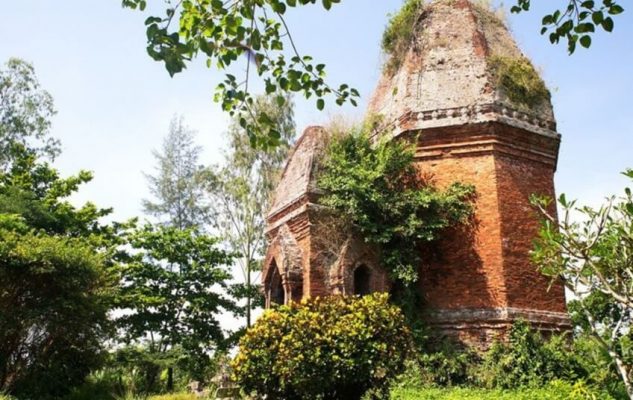
Through the ups and downs of time, some of the sub-structures of the mossy Bang An tower have disappeared or been damaged, leaving only the main tower and two sandstone statues in the outer hall. The Tower of Bang An is the only tower with an octagonal plan that is still relatively intact today in our country. Like other Cham towers, Bang An tower also turns the door to the East to catch the sun. The campus is about 4000m2 and surrounded by rice fields, the tower is about 21.5 meters high divided into a foyer and shrine.
Duy Xuyen
My Son Sanctuary
My Son Sanctuary is located in Duy Phu commune, about 69 km from Da Nang city and near the ancient citadel of Tra Kieu, including many Champa temples, in a valley about 2 km in diameter, surrounded by hills and mountains. This used to be the place of worship of the Champa dynasty as well as the tomb of the Champa kings or princes and national favorites. The My Son Sanctuary is considered one of the main Hindu temple centers in Southeast Asia and is the only heritage of its kind in Vietnam.
Ancient Citadel of Tra Kieu
In Cham epitaphs saved this Citadel under the name Simhapura – ie Lion City. Singapura was born during the reign of King Bhavavarman who ruled Champa around the end of the 4th century. Unfortunately, we have only partially restored to My Son until now, and Tra Kieu has a silhouette of the ancient capital of the kingdom of Champa (or also known as Lam Hamlet), located on the banks of the Thu Bon River, only the foot of the wall of the citadel is buried, buried in rock or condensed in a few small pages of history.
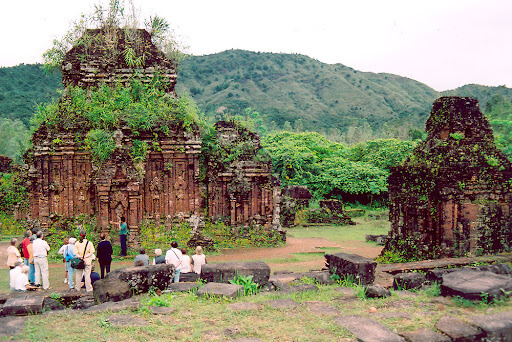
Nuoc Lang Stream
Nuoc Lang – the name of the stream located next to Highway 14E, in Nuoc Lang village, Phuoc Xuan commune, about 7km from Kham Duc town of Phuoc Son in the direction of Hiep Duc. The stream has three short steps of the waterfall, the map of clear blue water, cool, whispering among the old forest canopy.
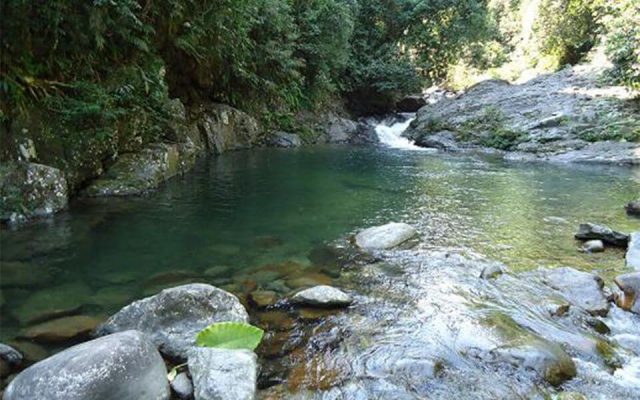
Que Son
Fairy Stream
Suoi Tien is considered one of the most beautiful streams in the Central region with a system of 14 waterfalls, white waterfalls flowing in a rush like white silk fluttering in the middle of the thousand. Fourteen waterfalls with 14 separate beauties for visitors to immerse themselves, dream, and explore. At the foot of Suoi Tien is an artificial lake built to be both an irrigation lake serving irrigation water for agricultural production, and an ecological lake for tourism. The landscape here is very poetic, with clear blue water, the flat surface of the lake reflecting the trees, in the shape of the mountain, creating a charming painting.
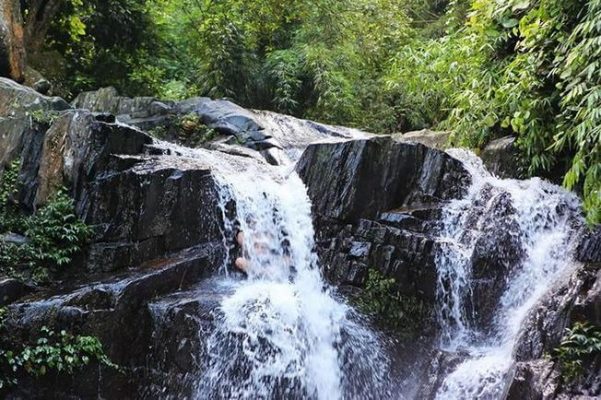
Que Minh Hat Village
400 years ago, Que Minh conical hat craft village began to take shape in 2 villages: Dien Loc and Dai Loc. At first, only a few households were working as a profession, then more than 300 households later developed. There are times when, every day, hat makers in Que Minh can stare at more than 2,000 hats and sell them throughout the region in the Central region. Que Minh hat village is one of the oldest craft villages in Que Son, known throughout Quang and maintained to this day.
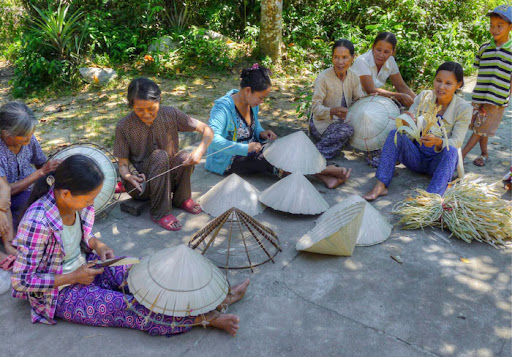
Hiep Duc
Thu Bon river (Thu river) originates from thousands of streams and hundreds of streams on Ngoc Linh plateau (Kon Tum). The river goes to find the east, through Tra My, confluence with Tran river, through Tien Phuoc, confluence with Tien river forming a vast and immense stream. Through the basin of Hiep Duc – Que Son, the river makes a majestic natural phenomenon. That is where the river flow impacts the mountains, the mountains block the river, so the waves are blazingly strong.
Quang Nam people call this basin Hon Kem – Stone Stop. In Quang Nam culture, Hon Kem – Stone Stop is a symbol of father and motherhood: “Look up at Hon Kem – Rock Stop / Love you so much, dear friends”
In 1986, after a part of Que Son district was split to belong to Hiep Duc district, Hon Kem Da Stop brought a new task: the boundary of the two districts. The whole section of the river is full of overhanging rocks, the currents are meandering and the water seems to be more swift. Right in the Hon Kem area, the river was drifting between two cliffs. The river seemed to fall inside. It was usually less sunny, smoggy, and colder than outside. It seems the day comes slowly and the night falls quickly. On both sides of cliffs, thick wild trees, monkeys live in groups.
Khe Cai
Khe Cai has a romantic but equally majestic beauty of waterfalls connecting pristine forests. Come to Khe Cai in the summer, soak in the cold water, listen to the sound of streams ringing, the sound of wild birds looking for friends, watch each other flock of fish chasing each other to hide and seek in the rocky cavity, visitors will immerse themselves in the feeling. peace in the wild.
Viet An Lake
The water surface area of Viet An lake is about 182ha wide, with a clean and beautiful landscape and rich flora and fauna. Coming to Viet An Lake, visitors not only enjoy the cool air that comes in from the lake’s surface but also immerse themselves in the melodies and folk tunes of the V zone, then enjoy local folk dishes.
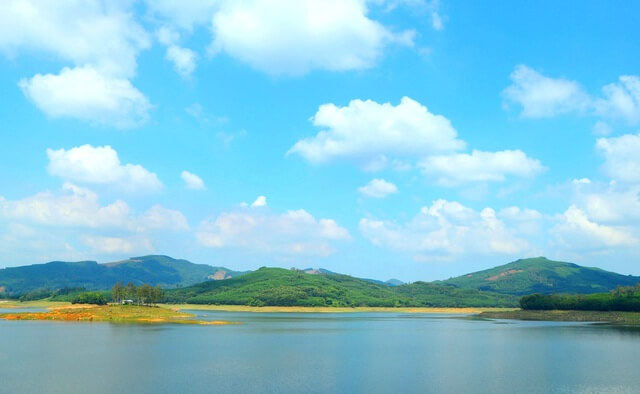
Tien Phuoc
Tien An Bat Cave
Located about 35km from Tam Ky city (Quang Nam), Tien An bat cave has a wild beauty like Jurassic park with a fossil map. Tien An bat cave is a system of caves and cliffs where visitors can admire the masterpieces of nature with the delicate works of rock. The cave complex of Bat Cave is divided into two parts: the upper cave and the lower cave. The lower cave is also called Thien Cave. Rocks form arches, walls, caves,… The curves across the rock body make visitors feel like they are lost in the wilderness with a magical or magical world. Bat Cave is very dark and humid and is an ideal shelter for bats. Occasionally you will hear a loud echo from the ravine, the sound of bats hiding somewhere.
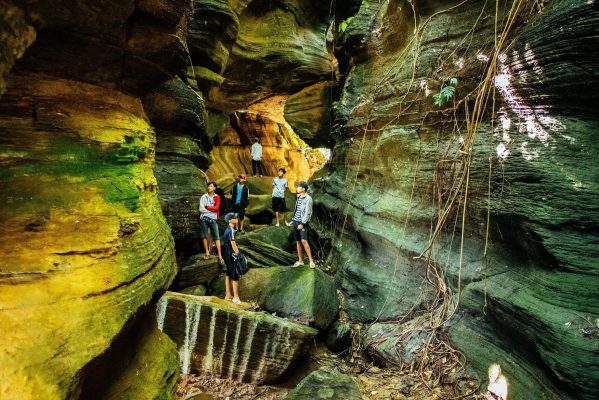
Loc Yen Ancient Village
Not only attracting tourists with hundreds of years old pure Vietnamese houses, Loc Yen’s ancient village (in Tien Canh, Tien Phuoc) also makes people overwhelmed from the first steps by the enchanting beauty of the alleys. The stone leads to the entrance to the house.
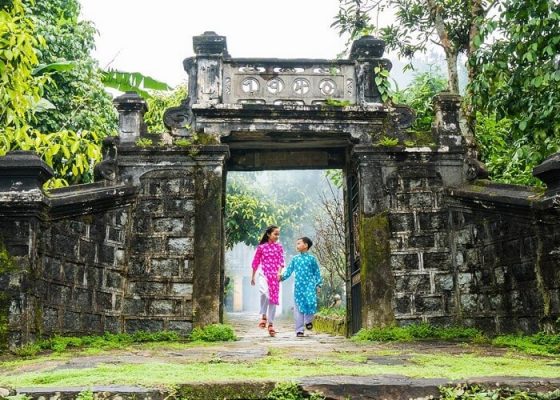
Loc Yen village still has more than ten old houses over 200 years old. The houses are pure Vietnamese, imbued with the house architecture of the old Quang Nam people. The house is made of jackfruit wood, two compartments, three wings, and a roof tile of yin and yang. Behind the house leaning back firmly on the mountain. The front of the house overlooks the deep rocky alley leading the way down to the green field. Not fussy, but naturally each house is like a villa.
Thang Binh
Binh Minh Beach
Binh Minh Beach in Thang Binh is probably still a relatively new thing to visitors. Although not an attractive tourist destination like Hoi An, this place promises to be a great destination contributing to resonating trips to Hoi An – Quang Nam with more excitement. It is still quite unspoiled, so here you will find calm and quiet, different from the vibrant and noisy beaches near Hoi An.
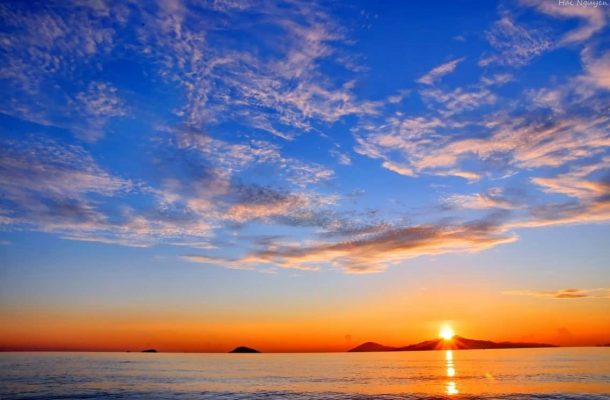
Dong Duong Buddhist Institute
Dong Duong Tower is the most important relic of Champa, consisting of a system of towers located close to each other, located in Dong Duong village. The tower was built in the Cham Pa period still influenced by Buddhism, so it has special properties compared to other towers in the Cham tower system, it is known as the Buddhist monastery in the middle of the city. Dong Duong tower system is located right in the center of Indrapura city during the Indrapura dynasty period. Currently, the whole temple complex has been destroyed by wars, natural disasters, and humans have turned it into a normal ruin with only the main foundation and a few traces of the walls, the doorstep.
Nui Thanh
Tam Hai
Called an island commune, but Tam Hai (Nui Thanh) is not far from the mainland. It is a few minutes by boat or ferry. Standing at Tam Hai – Tam Quang ferry (or Tam Quang T-bridge) looking over the island can still clearly see one of the fishermen’s boats anchored under the long, leaning coconut lines. Exploring the island always gives guests a sense of the peaceful scenery of a typical coastal village.
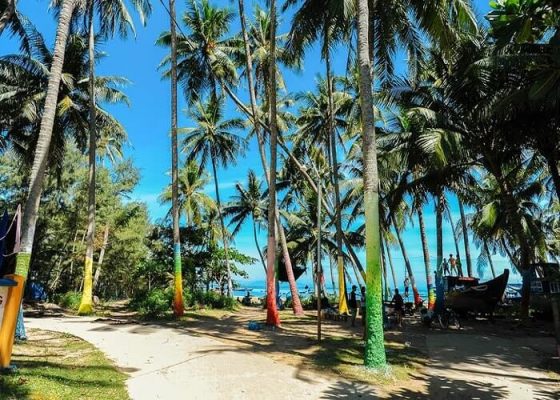
People in the Tam Hai commune drew the shape of the village they are living in like a wine gourd. The rock and water surround the village and every small, clean road in the village leads to the sea, all blending to create a picture of nature that is both wild and strangely beautiful.
Bang Than – Vung An Hoa
Along the coast of Tam Hai about 4km, we will reach the land of An Hoa cape. Perhaps the first impressive image that catches the eyes of visitors is a small island called Hon Dua, not far from the coast, the entrance to An Hoa puddle. In the afternoon, the island glows a red color of the land. The basalt and the green of the herb, stand out in the clear blue waters with waves undulating on the rocky shore, sending up white water bubbles like sea flowers.
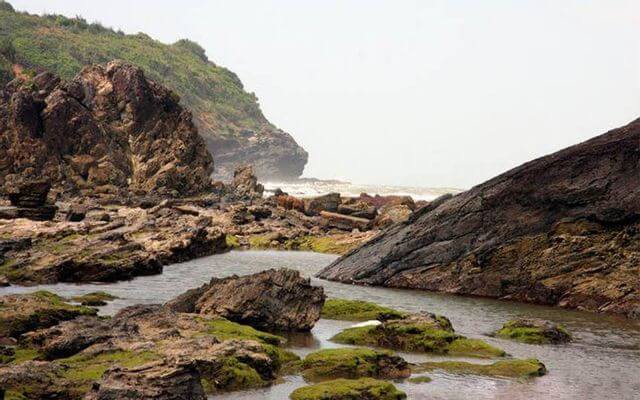
Each strip of sparkling black rock like coal stretches on the sandbank, around An Hoa cape about 3km, which is Bang Than (or Ban Than). Used to be layers of stacked rocks, they are shales originating from marine sediments. Water and waves intrude into the rock band forming fancy shapes, combined with the stone veins to become sculptures. unique engraving of nature.
Delicious food in Quang Nam
Hoi An Chicken Rice
Chicken rice is delicious, fragrant, and sticky rice, carefully selected, seasoned, and cooked with chicken broth and pineapple leaves in the woodstove. Chicken used is a kind of chicken with silk, the meat is soft but not fragile, firm but not chewy. After boiling, the chicken is shredded and then squeezed with onions, scallions, salt and pepper, and coriander. Finally, the rice is presented to a plate, the chicken is shredded on the rice, served with onion, sour papaya, Tra Que herbs, soy sauce, and chili sauce. In addition, there is a bowl of soup mixed with heart, liver, and chicken. With all the meticulous ingenuity in their processing, Hoi An people have created their very own chicken rice dish, bearing the imprint of Hoi An.
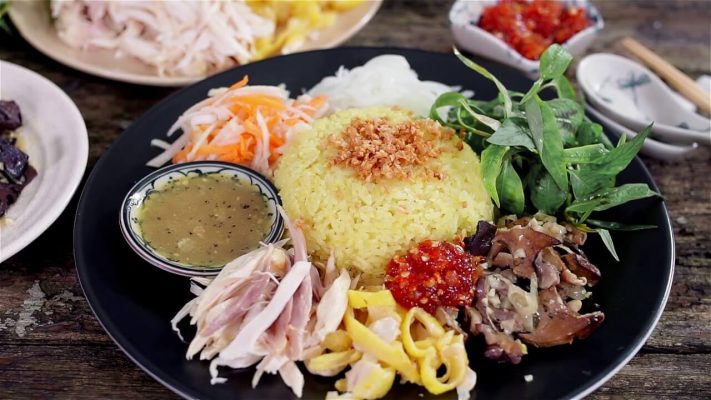
Cao Lau Hoi An
Cao Lau, unique dish associated with the ancient town of Hoi An. At first glance, it looks like noodles, but not noodles. Little is known about the high rise not because it is not delicious, but because this delicious dish is humble. Many people believe that this dish is Chinese, but the overseas Chinese here do not recognize it. And the Japanese think that it resembles their udon noodles but differs in taste and processing.
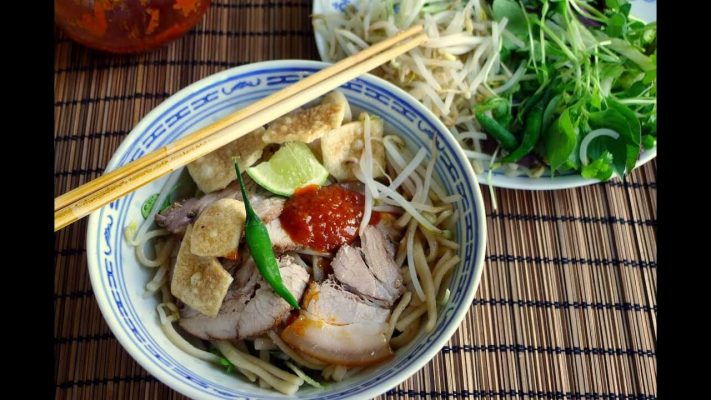
The essence of the high-rise dish is noodles, often very elaborate. First, fragrant rice is soaked in ash water, but it must be ashes for cooking firewood taken in Cu Lao Cham when soaked to create noodles that are crispy, flexible, and dry. Then filter carefully, grind into powder; Rice grinding water must be water in Ba Le well, made by the Cham thousands of years ago, to be freshwater, free from alum, and cool. Continue to use cotton many times to make the dough flexible, dry, rolled into pieces that fit, cut into strands, steamed several times, and then dried to make noodles. Through many times of handling like that, even if the building is upstairs to stay overnight, it is not afraid of rancidity.
People often eat upstairs at the price of boiling water but it is not too soft. Add some raw vegetables, taken from the famous traditional vegetable village of Tra Que, which is famous in Hoi An. Pour into a bowl, place the noodles on top, add a few slices of pork, then pour the fat (crispy pork skin), and a teaspoon of fried pork fat is available by the stove. With pork meat, only use grass pork, the meat is firm, fragrant, thin skin and leaner and its juice will taste sweet. When eating, the high floor gives a lumpy feeling of the noodles, full of sour, bitter, bitter, sweet flavors of raw vegetables, the taste of the fish sauce, fragrant powder, soy sauce … and the fat shrimp shatters in the mouth.
Quang Noodles
Quang noodles as well as pho and vermicelli are made from rice but have their own distinctive nuance and flavor. True to its name, this noodle originally originated from Quang Nam. To make noodles, people use good rice soaked in water to soften it, then build it into finely powdered water, just coincident (not thick, not liquid), mixed with a little alum to make the noodles crispy, hard, and then coated into noodles. When ripe, put on the blister to cool, apply a layer of oil to prevent pasta from sticking, then cut into fibers. Noodles (filled with noodles) in local languages also known as soup – made with shrimp, pork, or chicken, sometimes made with snakehead fish, beef,… are very diverse but more popular than rice, shrimp, meat or chicken.
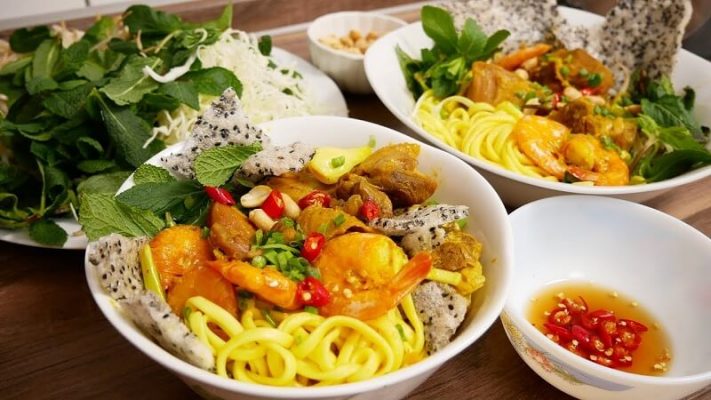
To make shrimp and meat fillings, they make raw shrimp, remove the oil, some of them crush them, some leave the whole. The bacon is just thinly sliced for seasoning shrimp and then put on the stove to absorb. Again add a few onions, pour them into a pot to cook tomatoes, pineapple (pineapple) to get the aroma, and sweetness for broth (water). For chicken pieces, after cleaning, chop into small pieces, mix the chili with pepper, onions, garlic, and soak in the kitchen, then cook with tomatoes, fragrant onions until cooked into broth. Noodles do not need much color, do not need much seasoning, but must be clear and sweet. This sweet is especially different from the sweetness of beef bone noodle soup, the broth of pork bone vermicelli. Raw vegetables to eat with regular noodles are bitter vegetables, fish lettuce, basil, basil, vegetables, onions, cilantro,… of the famous Tra Que vegetable region located northeast of Hoi An ancient town, eating Quang must. with fresh vegetables, Tra Que is the right “tone”. Only vegetables in this region can show all the many aromatic flavors: spicy, acrid, sweet, bitter,… enhancing the flavor of Quang noodle bowl.
Hoi An Noodle Soup
For those of you who have come to Hoi An many times, have enjoyed all the chicken rice, noodles, high-rise,… The noodles can be another option to experience. Noodles are arranged neatly in a bowl, plump, neatly with a few slices of meat, two slices of beef roll, including stomach and pork liver, mixed with a little taste of Chinese satay noodles, extremely attractive. The soup is clear, only a little yellow and yellow fat, humble, elegant, and gentle. Noodles are exceptionally chewy and not sour. The meat used for the noodle soup is also the meat used for the high-class dish, deep-fried, has a honey-brown color that looks very attractive, while the grilled meat is chewy. Vegetables served with rice noodles are crispy and sour slices of green papaya, a few stalks of a boat, and bean sprouts.
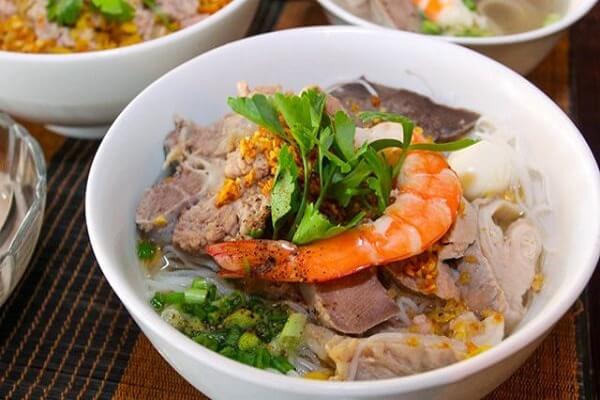
Hoi An Banh Mi
Banh Mi, the guide dish can be found everywhere in this country of Vietnam. However, have you ever wondered, where is the best bread in Vietnam? Type the keyword “best banh mi in Vietnam” (use the English keyword to get objective reviews from Western friends who have not eaten bread since childhood like us. The result you get is “Bread Phoenix in Hoi An ”.
There is the fact that Ms. Phuong, the owner of the shop, has served the “best” bread according to Caroline Mills, reporter of online travel magazine Travelfish, to Hoi An people, and perhaps to the whole world, for more than 20 years.
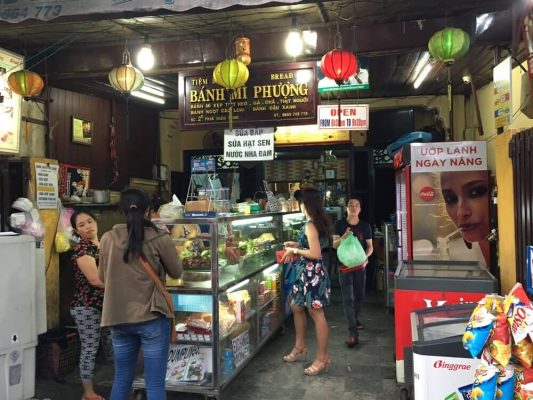
Regularly every day she woke up early, preparing to do things to stuff it with: the char siu pork chewed as if it was thawed, the pate and the jambon were deliciously delicious. Then a mysterious homemade sauce that makes your taste buds burst with glee!
It is hard to describe to the very extent the pleasure of chewing each piece of Phuong’s bread, which Anthony Bourdain describes as the “a symphony in a sandwich” but this is not that sandwich is “the world’s most popular bread as we all know it” (Caroline Mills).
Her small bakery was born before the renovation in Vietnam when the country opened its doors to foreign tourists for the first time. Hoi An at that time had not recovered from the aftermath of the war, most of the people in the old town were still poor and did not have many restaurants, only street vendors selling food.
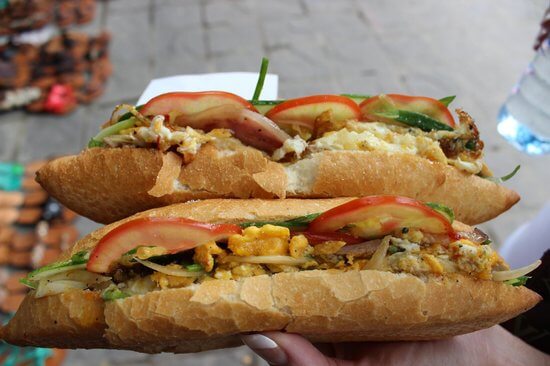
At that time, Phuong found a place in the old market to open a bakery. Every day she gets up at 3 am to prepare char siu pork and other additives, ready to serve the first customers to buy; while Phuong’s sister baked bread to be crispy and the batches were baked hot, sandwiched with meat, pâté, pickles,… so they were sold all day. Soon, Phuong Banh Mi became one of the most popular selling places in Hoi An.
The types of bread sold and the opening time of the store is still at 3 am in the morning. Maybe a little change is that the bread supplied to her shop comes from a bakery on the corner, and besides her sister, four other family members help her with shifts, because Phuong’s shop is now so famous, winter guests that no one has to wait long because there is a reasonable bread supply line, after only a few seconds the customer has received the hot dish.
Bánh bao – Bánh vạc
Dumplings – cauldrons are two types of cakes with nearly the same ingredients and are often eaten together on a plate of cake. The main raw materials for processing these two types of cakes are rice, which is white, whole grain, flexible, and fragrant, grown on clean land. The cauldron cake is made from crushed earthen shrimp mixed with a little pepper, garlic, onions, lemongrass, and esoteric spices. The dumpling filling is made from thinly sliced pork, mushrooms, green onions and sautéed with the same esoteric spices. Perhaps this spice is also a reason why the dumplings – cauldrons – can only be eaten deliciously in Hoi An.
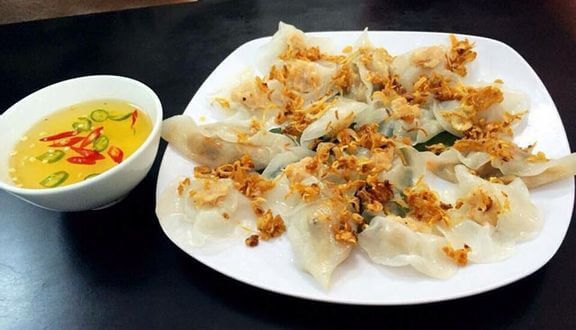
Bánh đập – Hến xào
Banh Dam (also known as Banh Xeo) is a popular cake that all Quang Nam people know. It is a harmonious combination of two kinds of baked rice paper and wet rice paper with some other ingredients to create a new flavor. The crispy cracker that dissolves in the mouth with stir-fried mussels is a very attractive dish in Hoi An.
The cake is coated with delicious sticky rice, one part is baked rice paper, one part is made of wet rice paper. With baked rice paper, the cake is extremely thin, then dried and baked on a red charcoal stove, then put in a sealed bag to keep the crispness for a long time and serve as a reserve. Wet rice paper, only when eaten.
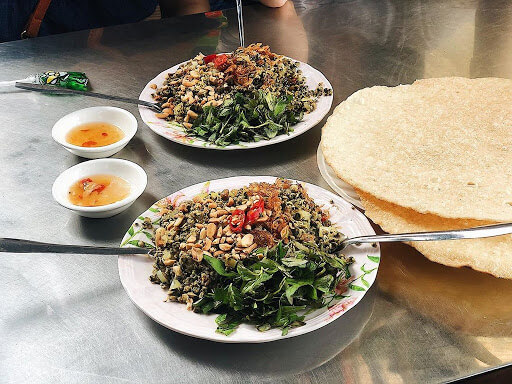
The batter is made up of these two types of cakes. Pair a piece of wet cake with a piece of crispy rice paper, over half a layer of wet cake wipes over a green bean paste, spread with onion oil. Depending on preferences, people can add leaf noodles (microfiber noodles) with wet rice paper.
Then use your hands to lightly smash the cake so that the two pieces of cake stick together. but wet, flexible. Then fold the cake in half and make a beat. Banh batter must be very thin to eat deliciously.
Eating biscuits as well as eating pancakes, must have sesame, dipping sauce, and chili food. Sauces are mixed with the female fish sauce. Fish sauce mixed with a bit of sugar, minced pineapple, a bit of oil, and onion, seasoned with a lot of garlic and special greenhorn chili of Quang, this type of chili when dipped into the sauce has a characteristic aroma. That is a cup of the finished dipping sauce. The sauce dish is just that simple, but it is surprisingly delicious.
Banh Xeo Hoi An
Banh Xeo is a typical folk dish of Vietnam, but depending on each region, Banh Xeo has different flavors, in different ways of processing, to suit the taste of each locality. as well as making use of the typical local resources. And of course Hoi An, a famous culinary city for bow cakes without exception, Banh Xeo is also one of the quite famous snacks in this land of Hoi.
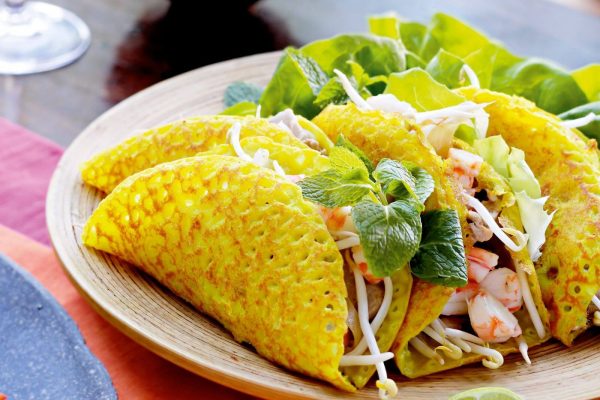
In Hoi An ancient town and in the cold season, Banh Xeo is the most popular type of cake. On these days, at any hour, customers come to eat in the restaurant. It is also possible to buy rain here, which is the season with the most shrimp, but the main ingredient to make the cake is shrimp. The plump, fresh, and sweet brackish shrimp (land shrimp) are indispensable ingredients to create the sweetness of the pancake. Meat is just an extra part, moreover, making Banh Xeo is very hot, so the rainy season is the best season for making this cake.
The attraction of this dish is thanks to the crispy taste of rice flour, the fatty taste of coconut milk, the aroma of turmeric powder mixed with herbs, besides the protein commonly used in beef, shrimp, and squid. The cake must be eaten hot to be delicious, right in style, it means you can eat it wherever you go and when you eat without using chopsticks or a spoon, just use your hands. The way of enjoying Banh Xeo, in addition to using the sense of smell and taste, forces the eater to use touch and hearing to see all the attractions. And it is especially suitable for all visitors on cold winter days. Normally when we eat pancakes, we are easily fed up with the fat taste of the cake which is fried with oil, fat, and protein in squid shrimp,… So you can enjoy delicious special teas in Hoi An.
Banh Beo Hoi An
Among dishes made from rice, after Quang noodles, Banh Beo is a dish that has captured the favor of many Hoi An residents, especially residents in rural areas.
To make Banh Beo, people choose a bowl of delicious rice to soak in water to soften the rice and then grind it into finely powdered water. Good or bad cake depends largely on this grinding stage. The powdered water should not be too thick, because the cake will be hard and less sticky. If it is too loose, the cake will be soft, not standing still (the cup is not sunken in the middle). This powdered water, when finished taking the irises (the technique of testing the plasticity and fineness of the powder), was put into a cup and then placed on a bamboo tray and placed in a pot to steam. The ripe cake is picked out to stack upside down to cool. The bowl of cake when ripe is pure white, soft, and in the middle, there is a round whirlpool, which is very funny. The cup for making water fern is a kind of glazed terracotta cup, smaller than the regular cup, but cute and round. Banh Beo (fillings) is mainly made from local products such as shrimp, meat … headless shrimp, minced, minced meat, mixed with marinated shrimp with spices, mixed with a little cashew powder ( red powder made from a fruit tree) for a more attractive sesame color, then bring to the stove to cook, mix with a little rice powder water, pour in, so that the ripe rice has a thick red-pink paste, the sweet taste. Fatty and spicy and aromatic are satisfactory. Cooked bamboo is stored in a small pot, on top of which is a layer of black pepper dotted and a few chopped green onions.
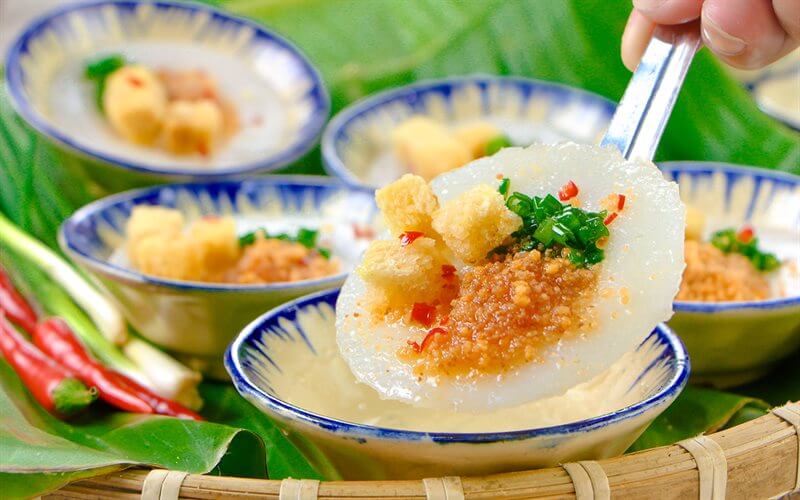
Banh Beo is present all over Hoi An, but more than that is still the areas along Hoi street such as Cam Chau, Cam Nam,… with simple but cool, cozy leaf shops. Guests entering the restaurant, the owner arranges many cups of cake on the tray, scoop it but pour it, add oil, chili sauce, fragrant onion and then place it on the table. Depending on the taste of the person eating, you can add a little fish sauce or a little chili. Looking at the cup of white duckweed cake, the middle of the pink color of shrimp and meat is like the pistil of a blooming flower. Adding a strong and attractive aroma makes the eatery want to eat dozens of cups of water cake at once. The utensils to eat the Banh Beo do not have to use chopsticks, nor use a spoon, but use a bamboo stick to scoop out the blade shape, called “bamboo knife”. This style of eating also evokes curiosity for guests and is also a different way of cuisine between Banh Beo and other rice cakes.
Tam Huu
Tam Huu is a delicacy on the menu of Tra Que vegetable villagers on important occasions and is also the most popular dish for visitors to Hoi An. Tam Huu is a unique combination of shrimp – meat – vegetables. Roll the tam right, dab into a cup of garlic chili fish sauce mixed with hand to feel the taste of thyme, the aroma of onion and the fatty taste of bacon, the sweet aroma of land shrimp.
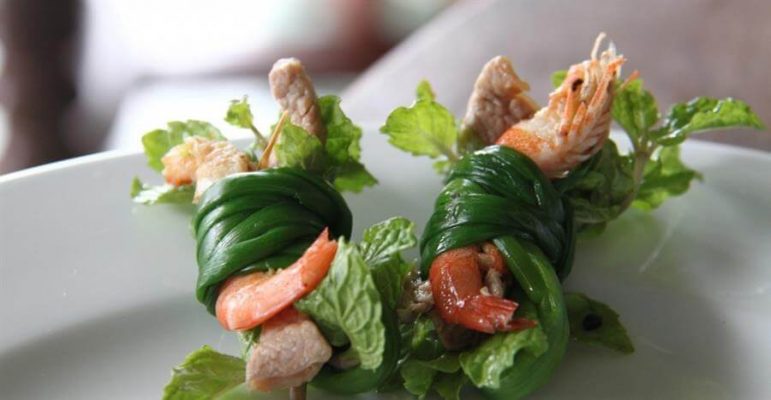
Bamboo Chicken Deo Le
If you want to enjoy delicious chicken properly, you must find the Le Pass foot in the land of Que Son. The dishes made from Le Le bamboo chicken are very diverse, from grilled, steamed onions, and boiled … but the most delicious and flavorful is the grilled chicken.
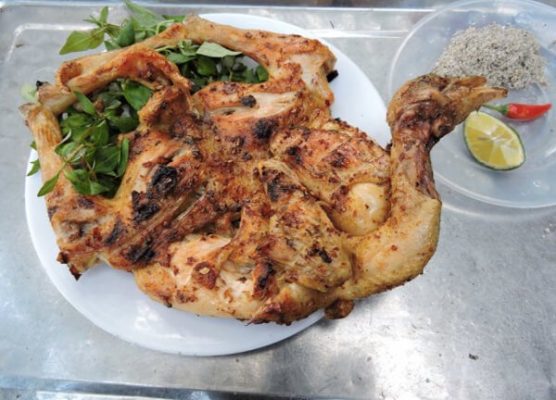
Chicken is processed to a whole chicken, underneath is laksa leaves to mix with meat, above is crushed purple onion and chopped lemon leaves. Le pass chickens are raised naturally, not locked in cages, so the chicken is firm, sweet but still very soft. Chicken after processing can be chewed on the bones, served with salt, pepper, and chili, but it’s spicy in Quang Nam.
Calves Cau Mong
One of the specialties in Quang Nam ranked on par with Quang noodles is Cau Mong veal. If you want to enjoy the authentic Cau Mong calf, you must come to Dien Ban land.
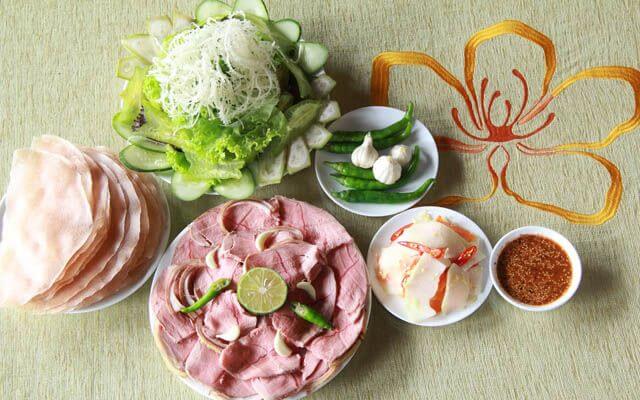
The calves chosen are just large enough that the meat is not tender. Raw veal must be pink-red but not raw, yellow skin but not dry, not chewy and smoky. The fish sauce must come from pure anchovy and scallop fish. The rice paper to roll veal must be a small, thin, and chewy rice paper made from famous bakeries in Dien Ban. The bitter banana pieces with the papaya salad are sour, sour, sweet, and will make the veal dish tasteless and less giddy.
Que Son Cassava Pho
To the people of Que Son, cassava is a familiar food crop, grown among hill gardens, in a narrow space in a small garden with all kinds of fruits. In the crowd, cassava trees are planted all year round, with a pillow crop, the next season. Cassava is processed into many dishes here, but the most meticulous is the cassava noodle dish, which is often cooked to present a party or to treat friends and relatives to come to Que Son.
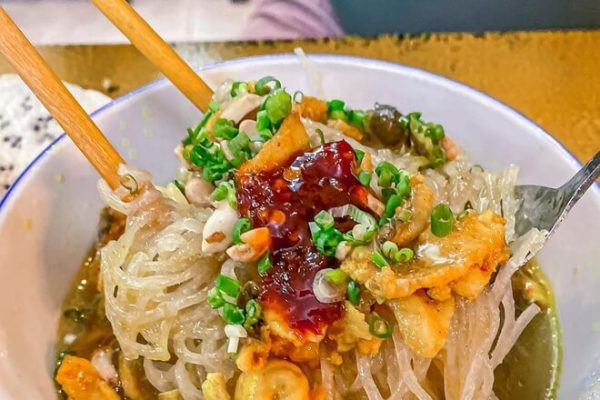
A bowl of cassava noodles is hot and fragrant, giving it a strange taste that has created a traditional craft village in the land of Que Son, which is the profession of making pho. Over time, through many kinds of rice noodles, the Que Son people concluded that this pho cake only really reaches the perfect taste when accompanied by the broth from the snakehead fish. Fish bought and washed with salt water, stuffed into the fish stomach a few blocks of crushed onions to deodorize fish, and then put in a boiling pot just cooked.
Take out the fish, let it cool, separate the meat and marinate it with familiar spices such as turmeric, compress, chili, fish sauce, salt, peanut oil,… Fishbones and heads are put in a pot to boil freshwater, then filter out the bones. . Next, the marinated fish will be put into a pan to stir-fry to absorb spices and then pour into the pot of broth. Cassava noodles are soaked in cold water for a few minutes so that the fibers are soft and chewy, and picked out to dry.
Pho is quite special with young crispy banana stems, herbs, some cinnamon leaves, and fragrant chives. Roasted peanuts, green peppers, lemons, cilantro, and garlic chili fish sauce are indispensable spices to make a bowl of delicious cassava pho.
Green Eel Porridge
Having the opportunity to come to Binh Dinh village, Thang Binh, visitors may find it difficult to hold back with a traditional dish of many generations, the green eel porridge, also known as rice eel porridge.
Because eating eel porridge with broccoli, the people here call it green eel porridge. The green eel dish is cooked with si rice, a local rice variety that dates back to the earliest times, is sticky, fragrant, and has a very sweet taste. When eating, Quang has two ways. Someone always puts cabbage and vegetables, broken rice paper into a bowl of porridge, blowing while scooping each spoon into his mouth to rub it. Others leisurely put each stalk of broccoli into each porridge to see the scent of broccoli, the pulp of beans, the fatty taste of eel, the sweet taste faintly the scent of home rice. But all of them eat hot and sometimes bite a piece of green pepper, making everyone sit near and craving to eat.
Cactus
Cactus is a fairly popular dish and can be considered specialty tourism in Quang Nam. This dish has ingredients that are easy to find, attractive because of its unique taste and not too sophisticated processing.
Before processing, cacti need to be preliminarily processed by peeling off the outer thorns with the green film, then sliced and then boiled to reduce the viscosity, until the pieces of the cactus turn yellow. These cacti pieces are then squeezed dry and can be processed into delicious dishes.
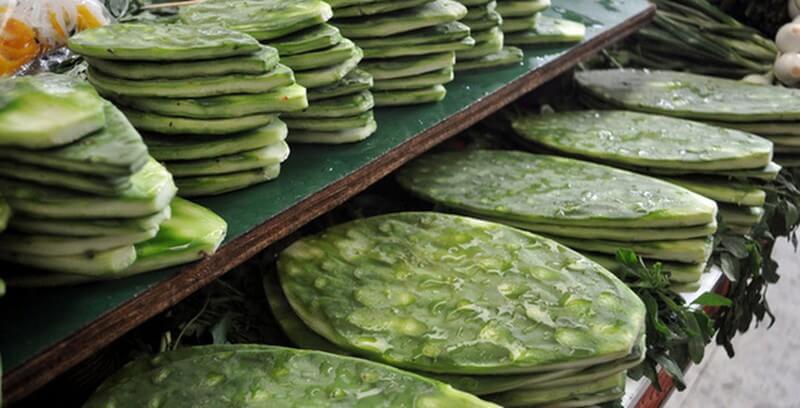
The most popular when visitors have the opportunity to visit Quang Nam land is the stir-fried cactus. On hot days, cactus sour soup is an effective cooling dish. In addition, the people of Quang also create another unique dish, cactus salad.
Măng Núi Trộn
The bamboo shoots, after peeling, are cut into thin, small, and finger-long strands, because if they are chopped a little thick, the spices will not absorb, eating will be hard, not delicious. Finished chopped bamboo shoots will wash through a turn of the water and then drop into a pot of boiling water for about 5 minutes. When bamboo shoots are just cooked, take them out to the basket to drain the water.
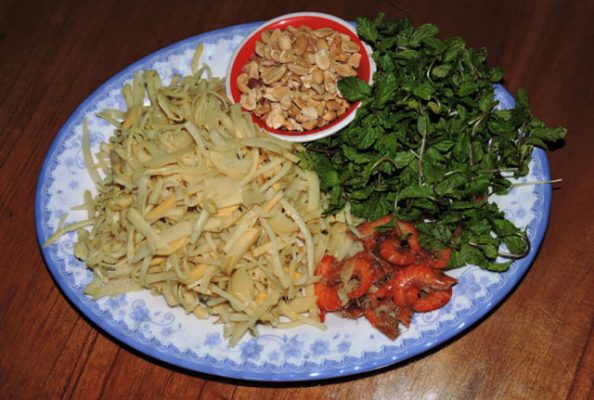
The special thing about this mixed bamboo shoot is that there is no need for sauces, soy sauce, shrimp, meat, or anything else. Just making a bowl of garlic fish sauce, chili (a kind of chili pepper, small fruit, many seeds, often found in the mountainous areas of Quang Nam) is hot enough to be attractive enough. To make the dish more aromatic and fatty, take some non-aromatic peanut oil with crushed bulbs until the compression turns yellow.
Squid Rice
Squid rice is exploited near the coast, the squid has fresh skin and also blinks stars, boiled on pink fire, fresh and juicy. When you eat, you dip in a bowl of fish sauce to add a little ginger and chili, along with some basil,… The sweet, fatty, squid rice flavor will hold the visitors’ feet. Sea-level rise squid has been recognized as the Top 50 famous Vietnamese dishes by a Vietnamese record organization. You can find this dish when you go to Binh Minh Beach in the Thang Binh district.
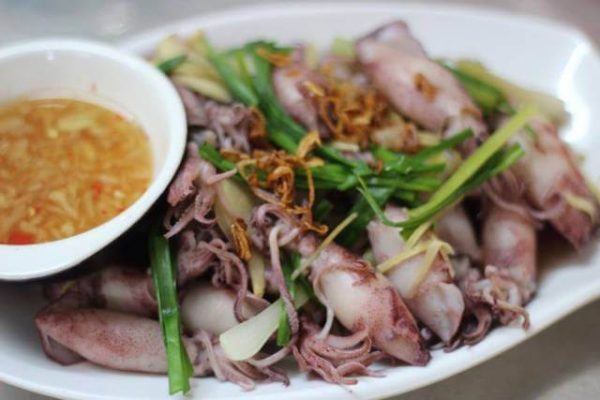
Grilled Dragonfish
About Nui Thanh, no one does not know the dish of grilled green flying fish dipped in chili sauce, eating and breathing in the sunset on Rang beach. Fish dragonflies are delicious, usually in the season between March and May of the lunar calendar. How to eat grilled green dragonfish just holding it whole in hand, breaking it in half into pure fish sauce or green pepper raw salt is nothing more interesting. But it would be more wonderful if the dragonfish was grilled in rice paper (rice paper roll) with raw vegetables, chili fish sauce,…
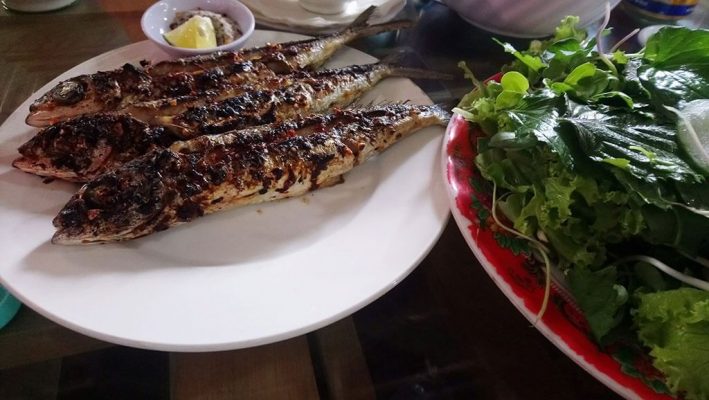
Bánh Tổ Hội An
Bánh Tổ is a specialty of the Quang Nam people. Many localities in the province have their own ways to create a characteristic for this type of cake. In Hoi An, the cake appeared quite a long time, at the same time with the formation of the old town, was imported by the Chinese from the sixteenth – seventeenth centuries and exists until today. Nest cake with the high floor is 2 traditional dishes, typical for Hoi An culinary culture. In the past, the nest cake was simply made to worship the ancestors. Due to its unique sweet taste, the cake can survive in the commercial portland and gradually present in most localities in the province.
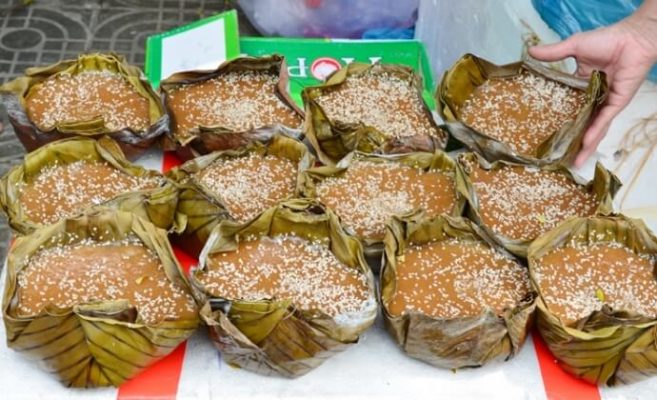
The ingredients for baking need to be pure sticky rice, so they are purchased from fertile Duy Xuyen fields. Sugar must be bowl sugar, the best is Dai Loc. If you want the cake to be delicious, the glutinous rice powder must be crushed, not ground, after soaking and smoothing it evenly. “Crushed glutinous rice powder needs to be stuffed” coincidentally “with the won sugar, but it will be broken or pasty. The cake must be steamed tightly after squeezing with banana leaves. During the cooking process, when the steam seeps through the banana leaves, the water starts to boil, then burn incense and wait for the cake to cook, after 3 weeks of burning, then stop, wait for another cooking. After picking up the cake, store it in a cool place after 3-4 days depending on the weather before it can be dried in the sun.
Quang Nam Travel Schedule
Explore Cu Lao Cham during the day
With this schedule, you need to be available in Hoi An ancient town, just arrange a time to explore Cu Lao Cham for the day and then return to the old town.
- At 7:00 am present at the pier right in the ancient town of Hoi An
- At 8:00 pm move to Cu Lao Cham, take about 1 hour if traveling by market train and 20 minutes if by can
- 9:30: Arrive at Cu Lao Cham, visit the marine reserve at the port
- At 10h30: Rent a boat to go around the island, go along the beaches and the Yen exploitation area, before going, you can book lunch at the homestay or some restaurants on the island.
- At 12h00: Back to the house to have dinner and rest
- At 13h30: Visit some places such as Ancient Water Well, Hai Tang Pagoda,…
- At 15h00 – 17h00: Snorkeling and swimming freely
- Rent canoes back to the mainland
Tour 1: Hanoi / Saigon – Da Nang – Hoi An – Cu Lao Cham
Day 1: Hanoi / Saigon – Da Nang
Fly from Hanoi or Saigon to Da Nang, in about an hour or so, you will be at Da Nang airport. You can fly around 10 am to get to Da Nang around noon, at the right time for hotels to check-in. Check in the hotel, rest, and then start your journey to explore Da Nang.
Going to Son Tra peninsula to visit places: Linh Ung Pagoda, Son Tra Tinh Vien Bamboo Reserve, explore the memory garden (Dong Dinh Museum), go to the Top of the Chess Table. If you like swimming, you can go to Bai But, you can bring food here to eat.
Afternoon departure to Ngu Hanh Son. You can visit the mysterious caves here Tang Chon Cave, Linh Nham Cave, Van Thong Cave, Hoa Nghiem Cave,… Linh Ung Pagoda was built in 1825, Tam Thai Pagoda was built in 1630.
After exploring the Cham Pa Museum of Sculpture, try to spend some time watching Danang from above with the Sun Wheel – Sun Wheel
Da Nang is known as the City of Bridges, so take a moment to go around the bridges of this beautiful coastal city.
The evening is the time to enjoy the delicious dishes of Danang. If you stay up at night to see the Han River swing bridge, this is one of the few rotating bridges still active to serve tourists.
Day 2: Da Nang – Hoi An
This day you depart for Hoi An from Da Nang, you can book a package ride from Da Nang and take you directly to the hotels in Hoi An. The price is about 200-220k, if you go by taxi, remember the price agreed in advance if calculated according to the taximeter will be quite high.
To Hoi An, check-in a hotel to store things, find a bicycle to walk around the old town and drink coffee in the morning. There are many delicious cafes right in the old town, just enjoy it slowly. Because Hoi An has many delicious dishes, you can slowly enjoy it from noon to evening. In the afternoon if you like, you can take a taxi to An Bang or Cua Dai beach (the beach in Cua Dai is now invaded by the sea. encroach quite a lot).
At night, watching the lanterns of the old town, if you go on the 14th day of the lunar month every month, the entire old town will turn off the electricity, you will be living in a space full of lanterns.
Day 3: Hoi An – Cu Lao Cham – Da Nang
Get up early in the morning to Cu Lao Cham, if you like to freely explore, you just need to go to Cua Dai pier to buy tickets to visit with train tickets and go to Cu Lao Cham by yourself. Rent a boat from the people on the island to take you to see the island, swim in the sea and watch the coral, enjoy seafood and return to Hoi An in the early afternoon. If not, you can buy a package tour to Cu Lao Cham with many units sold right in the old town.
Afternoon back to Hoi An and from here back to Da Nang, depending on the time of your flight to Hanoi / Saigon, you calculate the travel time accordingly.
Tour 2: Hanoi / Saigon – Hoi An – My Son – Tam Ky
Day 1: Hanoi / Saigon – Hoi An
On the first day, you will travel from Hanoi or Saigon to Da Nang, from here rent a taxi to Hoi An. Depending on the individual that you book the flight accordingly, but the most reasonable one would be to fly in the morning to arrive at Hoi An around noon.
Exploring Hoi An in about a day is okay, if you want more time to stay in Hoi An ancient town, or go to Cu Lao Cham island, you just need to add more days to this itinerary.
In Hoi An you can walk around the old town to drink coffee, enjoy delicious food in Hoi An, at night you can watch Hoi An from the Thu Bon river, drop flower lights,… generally, there is no shortage of activities for you to join.
Day 2: Hoi An – My Son – Tam Ky
The next noon, check out in Hoi An and find a tour to explore My Son back in the day, the distance from Hoi An to My Son is about 40km, or if you like you can rent a private car (motorbike or car) to go for the initiative. After returning to Hoi An you can take the bus route from Hoi An to Tam Ky. Evening rest in Tam Ky city.
Day 3: Explore Tam Ky
When you wake up in the morning, you can comfortably spend time eating breakfast, drinking coffee, and then start your journey to learn about Tam Ky. In Tam Ky, you can spend time visiting some places such as the Mother Thu monument, Tam Hai fishing village, Tam Thanh beach,…
Depending on your time, if you feel comfortable, you can arrange one to two more days to explore community tourism in the highland districts of Quang Nam. If not, it is possible to end the journey to go home. From Tam Ky, there are direct buses to Chu Lai airport and buses back to Da Nang city, depending on the flight itinerary you choose the appropriate route.
Related Article: Traveling experience in Ban Gioc Waterfall that tourist should know
Let start your trip to Quang Nam with us! If you have any feedback or need help, please send an email through vietnamreviewer.contact@gmail.com!
Noted: All information and pictures are collected

